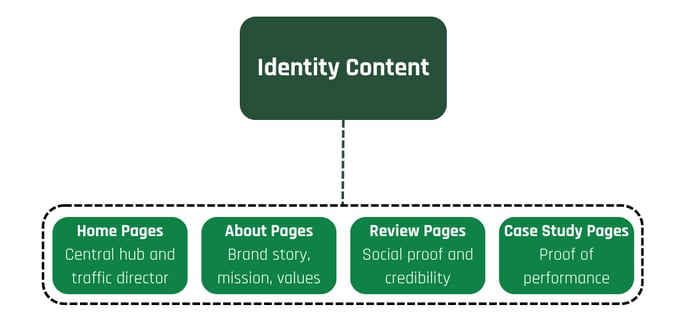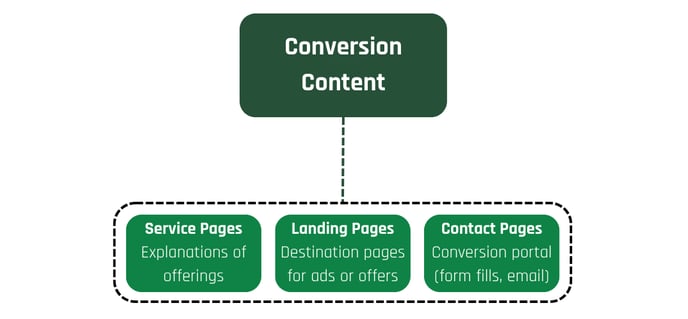A comprehensive framework to prepare for effective content writing.
Step 1: Determine your content type
- To-do: Determine what content medium you will be writing in.
There are 3 content classifications, each with various mediums:
Classification #1: Identity Content
(Mid-funnel content that explains who you are and what you do):

Classification #2: Conversion Content
(Low-funnel content intended to drive customers to action):

Classification #3: SEO Content
(Top-and-mid funnel traffic designed to improve online authority and relevance):

Step 2: Consider the SEO funnel
- To-do: Identify the funnel level and purpose for your selected medium.
As marketers, every piece of content should move leads further down the SEO Pyramid, from awareness to consideration to decision.

Using the following table, determine which stage of the SEO funnel your medium falls under and its associated purpose:
| Medium | Funnel Level | Purpose |
| Home Pages | Mid-Funnel | Consideration |
| About Pages | Mid-Funnel | Consideration |
| Review Pages | Low-Funnel | Decision |
| Case Study Pages | Low-Funnel | Decision |
| Service Pages | Low-Funnel | Decision |
| Landing Pages | Low-Funnel | Decision |
| Contact Pages | Low-Funnel | Decision |
| Blogs | High-Funnel | Awareness |
| eBooks | High-Funnel | Awareness |
Example: If I am writing home page body, it should be designed as a mid-funnel piece. In other words, it should be working towards consideration, explaining how the client stands out from other competitors in the same industry space.
Step 3: Use the Content Writing Technical Guide to determine technical specs
- To-do: Access the Content Writing Technical Guide and identify technical recommendations for your selected medium.
Marketing content is more technical than regular writing. It involves careful optimization of keywords, SEO titles, meta descriptions, internal/external links, structured headings, and length.
Remember: while regular writing is meant to inform, entertain, or express; marketing writing is meant to drive conversions.
To give you some targets for the technical requirements of each medium, Green House created a Content Writing Technical Guide. Within this guide, find the medium you will be writing and keep the technical specs in mind as we move forward.
Note: High-performing competitors have already found a "recipe for success with their content. Later, when we perform a competitor content audit, if there are any noticeable discrepancies from successful competitor content and the guidance given in the Content Writing Technical Guide, always go with what competitors are doing.
Step 4: Determine the intended audience
- To-do: Determine the intended audience you are writing to/for.
- If writing blogs for a client, your audience should be the client's target audience.
- If writing website content (pages) for a client, your audience should be based on the intent of the page.
Step 5: Identify the target keyword
Planning external marketing content should always start with a focus on the target keyword you are seeking to optimize. If you need help narrowing down your options, try using Moz's Keyword Explorer. You can also visit the SEO section of the KB for more ideas.
In most cases, pick a target keyword that is concise (i.e. not a question or long-tailed keyword) and has high search volume with low to medium difficulty, depending on the DA of your client.
Step 5: Determine the goal (CTA)
Be thinking about what step you want people to take next at each content piece. This is easily done through the marketing funnel model:
 For example, if you know that you are writing a blog (High-Funnel Content), you should be primarily driving brand awareness—AWARENESS—while preparing audiences to consider your client's product or service—CONSIDERATION. The CTA should capture this shift.
For example, if you know that you are writing a blog (High-Funnel Content), you should be primarily driving brand awareness—AWARENESS—while preparing audiences to consider your client's product or service—CONSIDERATION. The CTA should capture this shift.
If you need help identifying where your content falls on this funnel, The Content Writing Guide (Step 2) gives suggestions.
Remember: Internal website linking is your friend with CTAs! For example, a blog post (High-Funnel content) on a client's website may link to Case Studies or eBooks (Medium-Funnel content).
Step 6: Create an outline
Remember how marketing content is more technical than regular writing? This comes up a lot in the outlining process. But it's okay—headers are your best friend!
Rather than trying to eat an elephant in one bite, take it piece by piece. Try breaking up your content into subsections, or supporting points. Better yet, want to score higher on the SEO scale? Try including some long-tail keywords as sub-headers (H2 or H3)!
In this step, you may also need to carry out research. Try accessing the following resources for credible supporting information:
- IBISWorld
- UVU Database
- All students have access! Go to the Fulton Library website and login with your student ID credentials. If you are paywalled by a news source or professional journal, try searching the title in the UVU Database. You will be surprised by how much we have access to as students!
- Filetype: PDF Google Search
- American Marketing Association (AMA)
Step 7: Competitor Analysis
"Good artists copy, great artists steal." Before putting your ink to paper, be sure to check out high-ranking competitors targeting the same keyword.
- Do you think your approach is effective, or is there something you can adjust to make it better?
- If your approach is similar to competitors, how can you do it better than them?
Step 8: Design elements
Now it is time to start thinking about visual appeal. Visuals are like salt: too much can spoil a dish, to little will leave it bland. How can you make your content visually appealing and professional?
Consider using the following:
- Pull quotes
- Exciting images
- Intriguing graphs or charts
- Hyperlinked buttons
Using these elements, create a mental image of what you want your content to look like. Consider incorporating these design elements into your outline.
Note: Everybody has a "cognitive load." That means every word and every picture takes up some of the audience's ability to process what you are trying to tell them. Only use design elements if they effectively support your content.
Step 9: Write the content
At this point, your brain should be ready to explode! Get your ideas on paper and make sure to reference the outline to keep your writing focused. If you need help or get stuck, trying asking ChatGPT for help (sparingly—do not let it write for you!) or ask the Content Writer for assistance.
Step 10: Peer review
Good writing is reviewed writing. Ask your PM, ChatGPT, or the Content Writer to do a read-through of your content. Make sure to check for spelling and grammar errors, as well as continuity and conciseness.
